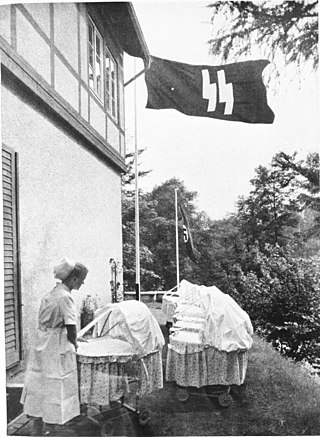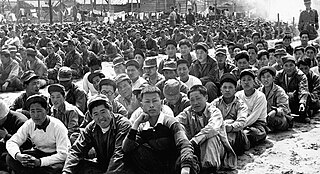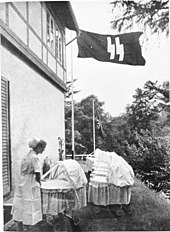
Lebensborn e.V. was a secret, SS-initiated, state-registered association in Nazi Germany with the stated goal of increasing the number of children born who met the Nazi standards of "racially pure" and "healthy" Aryans, based on Nazi eugenics. Lebensborn was established by Heinrich Himmler, and provided welfare to its mostly unmarried mothers, encouraged anonymous births by unmarried women at their maternity homes, and mediated adoption of children by likewise "racially pure" and "healthy" parents, particularly SS members and their families. The Cross of Honour of the German Mother was given to the women who bore the most Aryan children. Abortion was legalized by the Nazis for disabled and non-Germanic children, but strictly punished otherwise.

A prisoner-of-war camp is a site for the containment of enemy fighters captured as prisoners of war by a belligerent power in time of war.

The occupation of Norway by Nazi Germany during the Second World War began on 9 April 1940 after Operation Weserübung. Conventional armed resistance to the German invasion ended on 10 June 1940, and Nazi Germany controlled Norway until the capitulation of German forces in Europe on 8 May 1945. Throughout this period, a pro-German government named Den nasjonale regjering ruled Norway, while the Norwegian king Haakon VII and the prewar government escaped to London, where they formed a government in exile. Civil rule was effectively assumed by the Reichskommissariat Norwegen, which acted in collaboration with the pro-German puppet government. This period of military occupation is, in Norway, referred to as the "war years", "occupation period" or simply "the war".

The term "home front" covers the activities of the civilians in a nation at war. World War II was a total war; homeland military production became vital to both the Allied and Axis powers. Life on the home front during World War II was a significant part of the war effort for all participants and had a major impact on the outcome of the war. Governments became involved with new issues such as rationing, manpower allocation, home defense, evacuation in the face of air raids, and response to occupation by an enemy power. The morale and psychology of the people responded to leadership and propaganda. Typically women were mobilized to an unprecedented degree.

War brides are women who married military personnel from other countries in times of war or during military occupations, a practice that occurred in great frequency during World War I and World War II. Allied servicemen married many women in other countries where they were stationed at the end of the war, including the United States, the United Kingdom, Australia, New Zealand, China, Japan, France, Italy, Greece, Germany, Poland, Luxembourg, Thailand, Vietnam, the Philippines, Taiwan, Korea, and the Soviet Union. Similar marriages also occurred in Korea and Vietnam with the later wars in those countries involving U.S. troops and other anti-communist soldiers.

The entirety of Germany was occupied and administered by the Allies of World War II from the Berlin Declaration on 5 June 1945 to the establishment of West Germany on 23 May 1949. Unlike occupied Japan, Germany was stripped of its sovereignty and former state: after Nazi Germany surrendered on 8 May 1945, four countries representing the Allies asserted joint authority and sovereignty through the Allied Control Council (ACC). At first, Allied-occupied Germany was defined as all territories of Germany before the 1938 Nazi annexation of Austria; the Potsdam Agreement on 2 August 1945 defined the new eastern German border by giving Poland and the Soviet Union all regions of Germany east of the Oder–Neisse line and divided the remaining "Germany as a whole" into four occupation zones, each administered by one of the Allies.
During World War II, the Allies committed legally proven war crimes and violations of the laws of war against either civilians or military personnel of the Axis powers. At the end of World War II, many trials of Axis war criminals took place, most famously the Nuremberg Trials and Tokyo Trials. In Europe, these tribunals were set up under the authority of the London Charter, which only considered allegations of war crimes committed by people who acted in the interests of the Axis powers. Some war crimes involving Allied personnel were investigated by the Allied powers and led in some instances to courts-martial. Some incidents alleged by historians to have been crimes under the law of war in operation at the time were, for a variety of reasons, not investigated by the Allied powers during the war, or were investigated but not prosecuted.

The Deutsche Dienststelle (WASt) was a German government agency based in Berlin which maintained records of members of the former German Wehrmacht who were killed in action, as well as official military records of all military personnel during World War II as well as naval military records since 1871 and other war-related records. Formerly called the Wehrmachtsauskunftstelle für Kriegerverluste und Kriegsgefangene (WASt), the agency also provided information about the fate of foreign and German soldiers as well as prisoners of war in Germany. Such information is used for civil proceedings, for an official register of war graves, for historical research and as biographical and genealogical purposes.

During World War II, the German Wehrmacht committed systematic war crimes, including massacres, mass rape, looting, the exploitation of forced labour, the murder of three million Soviet prisoners of war, and participated in the extermination of Jews. While the Nazi Party's own SS forces was the organization most responsible for the genocidal killing of the Holocaust, the regular armed forces of the Wehrmacht committed many war crimes of their own, particularly on the Eastern Front.
Wartime collaboration is cooperation with the enemy against one's country of citizenship in wartime. As historian Gerhard Hirschfeld says, it "is as old as war and the occupation of foreign territory".

From 1917 to 1991, a multitude of war crimes and crimes against humanity were carried out by the Soviet Union or any of its Soviet republics, including the Russian Soviet Federative Socialist Republic and its armed forces. They include acts which were committed by the Red Army as well as acts which were committed by the country's secret police, NKVD, including its Internal Troops. In many cases, these acts were committed upon the direct orders of Soviet leaders Vladimir Lenin and Joseph Stalin in pursuance of the early Soviet policy of Red Terror as a means to justify executions and political repression. In other instances they were committed without orders by Soviet troops against prisoners of war or civilians of countries that had been in armed conflict with the USSR, or they were committed during partisan warfare.
The aftermath of World War II saw the rise of two global superpowers, the Soviet Union (USSR) and the United States (US). The aftermath of World War II was also defined by the rising threat of nuclear warfare, the creation and implementation of the United Nations as an intergovernmental organization, and the decolonization of Asia and Africa by European and East Asian powers, most notably by the United Kingdom, France, and Japan.
While black people in Nazi Germany were never subject to an organized mass extermination program, as in the cases of Jews, homosexuals, Romani, and Slavs, they were still considered by the Nazis to be an inferior race and along with Romani people were subject to the Nuremberg Laws under a supplementary decree. There is evidence that at least two dozen black Germans ended up in concentration camps in Germany.

As Allied troops entered and occupied German territory during the later stages of World War II, mass rapes of women took place both in connection with combat operations and during the subsequent occupation of Germany by soldiers from all advancing Allied armies, although a majority of scholars agree that the records show that a majority of the rapes were committed by Soviet occupation troops. The wartime rapes were followed by decades of silence.

Operation Weserübung was the invasion of Denmark and Norway by Nazi Germany during the Second World War and the opening operation of the Norwegian Campaign.

Military brothels were set up by Nazi Germany during World War II throughout much of occupied Europe for the use of Wehrmacht and SS soldiers. These brothels were generally new creations, but in the west, they were sometimes expansions of pre-existing brothels and other buildings. Until 1942, there were around 500 military brothels of this kind in German-occupied Europe, serving travelling soldiers and those withdrawn from the front. According to records, a minimum of 34,140 European women were forced to serve as prostitutes during the German occupation of their own countries along with female prisoners of concentration camp brothels. In many cases in Eastern Europe, teenage girls and women were kidnapped on the streets of occupied cities during German military and police round ups called łapanka in Polish or rafle in French.
The years leading up to World War II saw great changes in the sexual habits of European societies.
Brown Babies is a term used for children born to black soldiers and white women during and after the Second World War. Other names include "war babies" and "occupation babies." In Germany they were known as Mischlingskinder, a term first used under the Nazi regime for children of mixed Jewish-German parentage. As of 1955, African-American soldiers had fathered about 5,000 children in the American Zone of Occupied Germany. In Occupied Austria, estimates of children born to Austrian women and Allied soldiers ranged between 8,000 and 30,000, perhaps 500 of them biracial. In the United Kingdom, West Indian members of the British military, as well as African-American soldiers in the US Army, fathered 2,000 children during and after the war. A much smaller and unknown number, probably in the low hundreds, was born in the Netherlands, but the lives of some have been followed into their old age and it is possible to have a better understanding of the experience that would unfold for all of the Brown Babies of World War II Europe.

Two Lives is a 2012 German war drama film written and directed by Georg Maas, and starring Juliane Köhler, with Liv Ullmann. Set in Norway and Germany, it is loosely based on an unpublished novel by Hannelore Hippe since released as Ice Ages. The film explores the history of the Lebensborn or war children, born in Norway and raised in Germany. It explores the life of a grown woman who had claimed to have escaped from East Germany, where she was raised, and her Norwegian mother, with whom she is reunited.

Horizontal collaboration referred to the romantic or sexual relationship many women in France had or allegedly had with members of the German occupation forces after the Fall of France in 1940. The existence of these liaisons had been a major reason for young men to join the French Resistance. After the Liberation of France from German occupation, such women were often punished for collaboration with the German occupiers.














